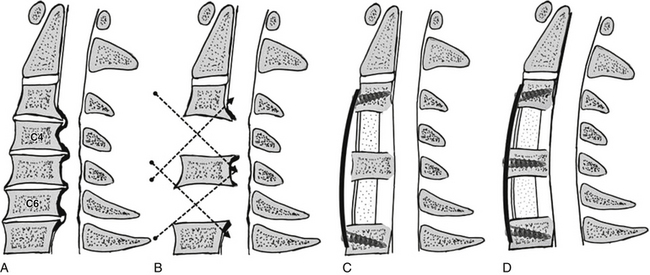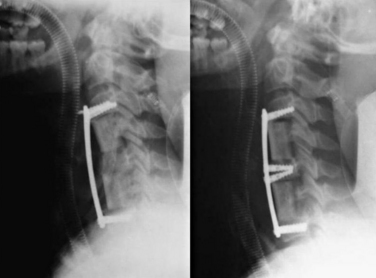Chapter 45 Cervical Skip Corpectomy
The ventral approach to the cervical spine was first suggested by Dr. Leroy Abbott in 1952. The approach was used and subsequently described by Bailey and Badgley.1 During the late 1950s and 1960s many approaches and techniques were defined to obtain a successful neural decompression and cervical spine arthrodesis.2 All these frontier studies focused on anterior cervical discectomy and arthrodesis.
Evolution of new techniques facilitated the complex surgical procedures, leading surgeons to use more aggressive techniques in cases with traumatic, degenerative, infectious, and neoplastic disorders. As a result, the first cervical corpectomy procedures were performed in 1970s. With time cervical ventral and dorsal plating techniques were developed.3
Cervical corpectomy is an effective procedure decompressing the ventral spinal cord. The existing literature indicates that the success rate usually is good for single-level or two-level cervical corpectomy, but not for multilevel corpectomy.4–15 On the other hand, although this surgery is associated with good results in terms of neurologic recovery, many complications, such as strut graft fracture, graft pistoning, graft dislodgement, hardware failure, and pseudoarthrosis, are also part of its history.
Vaccaro et al. demonstrated high rates of early construct failure in multilevel fusions: 9% for two-level corpectomy, and 50% for three-level corpectomy.15 A similar high rate of construct failure after multilevel corpectomy was reported by others as well.6,7,10,11,15–19 The reported high rate of failure indicates that reconstruction of a multilevel corpectomy defect in the cervical spine remains a challenge.
Biomechanics of Cervical Corpectomy
The evidence of failure of long constructs has been investigated in biomechanical studies.20–22 Cadaveric biomechanical studies showed that the longer plate generates greater motions at the fusion sites under physiologic loads because of its longer lever arm,23 and that the stabilizing potential indices significantly decrease after fatigue for the three-level corpectomy, but not for the one-level corpectomy.16,17,23–25 This explains the lesser rate of construct failure in one-level cervical corpectomies.
Cervical corpectomy results in a posterior shift of the center of rotation, as the anterior aspect of the spine is cut. Addition of an anterior cervical plate shifts the center of rotation to the anterior, thus changing the loading pattern.16,17,24 In other words, whereas the stand-alone strut graft is loaded in flexion and unloaded in extension,16,17 the addition of a plate completely reverses the loading pattern. The outcome is reversal of the loading pattern in anterior-plated long-strut grafts so that loading of the graft does not occur under flexion moments, and excessive compression of the graft occurs under extension loads, resulting in the graft pistoning into the caudal vertebral end plate and, subsequently, in plate kicking.16,17
Alternative Solutions
Based on clinical experiences and biomechanical facts, many alternative techniques have been developed to avoid graft plate-related problems in cases of multilevel corpectomy.4,6,8,13,26–30
Based on the evidence of the high stress in the lower end of the construct, the use of a buttress (junctional) plate alone was recommended. However, Riew et al.27 and MacDonald et al.8 reported high rates of complication after the use of a buttress plate alone in multilevel corpectomy. They recommended that the buttress plate be supplemented with posterior fixation.8,27,30
Others focused on the 360-degree fixation using long plates.4,6,13,26 However, the 360-degree procedure is a lengthy, sometimes staged procedure.
Different combinations of multilevel anterior cervical discectomy and fusion (ACDF) with or without corpectomies are other alternatives. As ventral alternative approaches to three-level corpectomy, Rhee and Riew31 proposed (1) multilevel ACDF, (2) single corpectomy combined with additional ACDFs, and (3) two single-level corpectomies separated by an intact intervening vertebra. As another alternative, Ozer et al. described an open-window corpectomy technique.32
Indications of Skip Corpectomy
The skip corpectomy is indicated and is applicable in compressions extending from C3-4 to C6-7, particularly when the area of compression at the C5 level is confined to the adjacent disc spaces (Fig. 45-1A). This is so because skip corpectomy allows optimal decompression of the C3-4, C4-5, C5-6, and C6-7 intervertebral disc levels and C4 and C6 vertebral body levels (Fig. 45-1B). However, the limited work angle does not allow for optimum decompression of the posterior aspect of the C5 vertebral body, as seen in continuing ossification of the posterior longitudinal ligament (OPLL) cases. Note, however, that the surgeon may change strategy during the procedure and can add a C5 corpectomy if the decompression behind the C5 vertebral body is not satisfactory. Such an additional C5 corpectomy means a three-level corpectomy and should be combined with a posterior stabilization procedure.
Skip Corpectomy Technique
The skip corpectomy technique is exemplified by a C4 and C6 corpectomy, C5 osteophytectomy, and decompression of dorsal-rostral and dorsal-caudal aspects of the C5 vertebra. Preservation of the C5 vertebral body and the use of this vertebra for screw fixation are the most important aspects of this technique. Reconstruction can be performed using either iliac crest autograft or fibula allograft. After placement of the C3-5 and C5-7 bone grafts, a fixed rigid ventral cervical spine plate is placed (Fig. 45-1C). The plate is contoured in lordosis. The intervening vertebral body that is left after C4 and C6 decompression (i.e., the C5 vertebral body) serves as an intermediate point of construct fixation. The plate is first secured at the rostral and caudal ends (the C3 and C7 vertebral bodies). Next, screws are placed into the intervening vertebral body (the C5 vertebral body). As the C5 vertebral body screws are tightened, the spine is “brought to the cervical plate” (Figs. 45-1D and 45-2). Figure 45-3 shows preoperative and postoperative images of a patient who underwent skip corpectomy.
Stay updated, free articles. Join our Telegram channel

Full access? Get Clinical Tree









